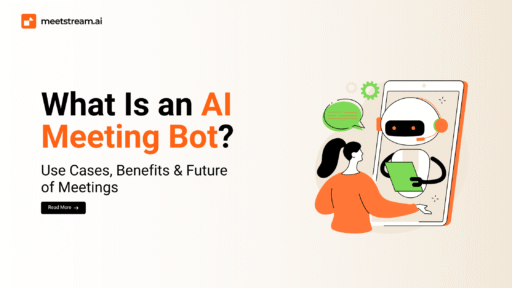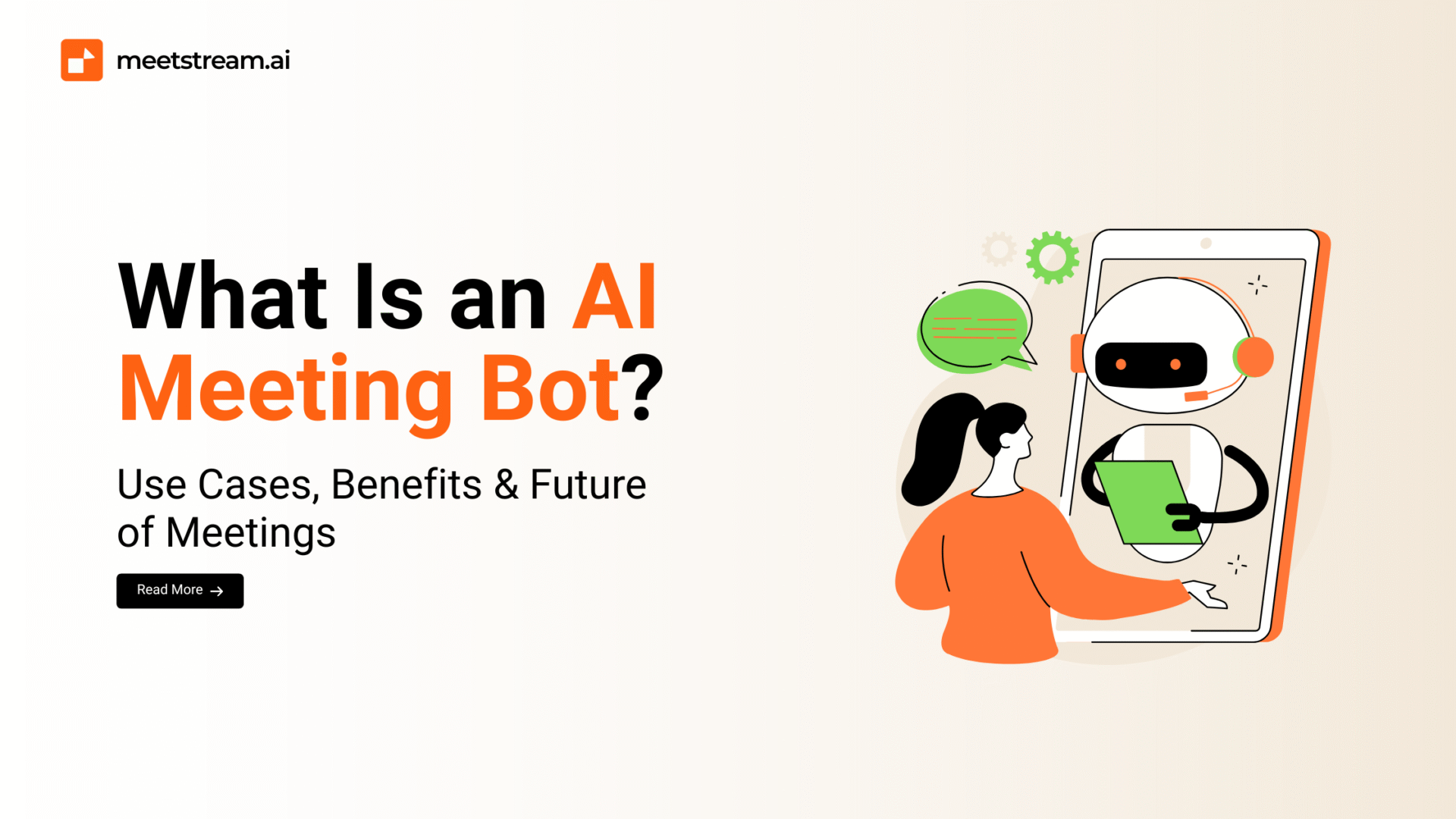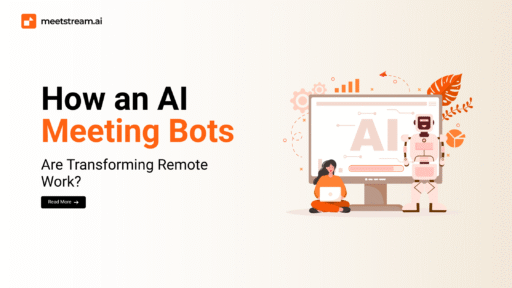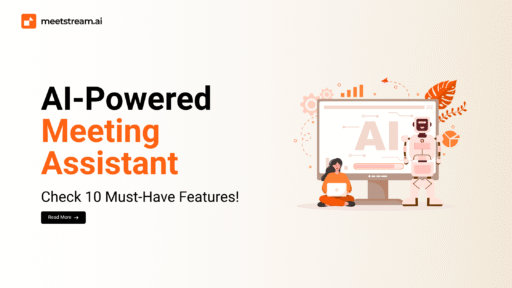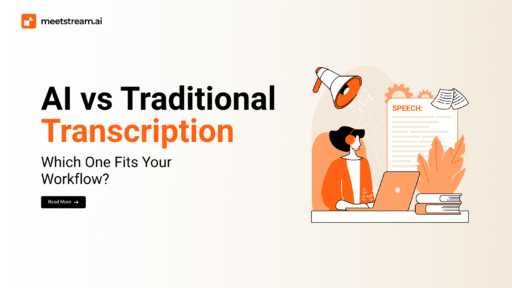In today’s fast-paced hybrid work environment, AI meeting bots are transforming how organizations manage virtual meetings.
From real-time transcription to automatic task syncing, these intelligent assistants streamline communication, eliminate manual work, and boost operational efficiency across industries.
Whether you’re leading global sales calls, hosting internal project check-ins, or running HR interviews, AI meeting bots are now essential tools for modern business collaboration.
What Is an AI Meeting Bot?
An AI meeting bot is an intelligent software assistant designed to join virtual meetings on platforms like Zoom, Google Meet, Microsoft Teams, and more.
Once added to your calendar or conferencing tool, it autonomously captures conversations, transcribes discussions, identifies speakers, and delivers structured summaries with assigned action items.
These bots utilize cutting-edge technologies such as:
- Automatic Speech Recognition (ASR)
- Natural Language Processing (NLP)
- Machine Learning Algorithms
- Conversational AI
They aren’t just note-takers — they’re workflow automation engines that remove friction from team collaboration.
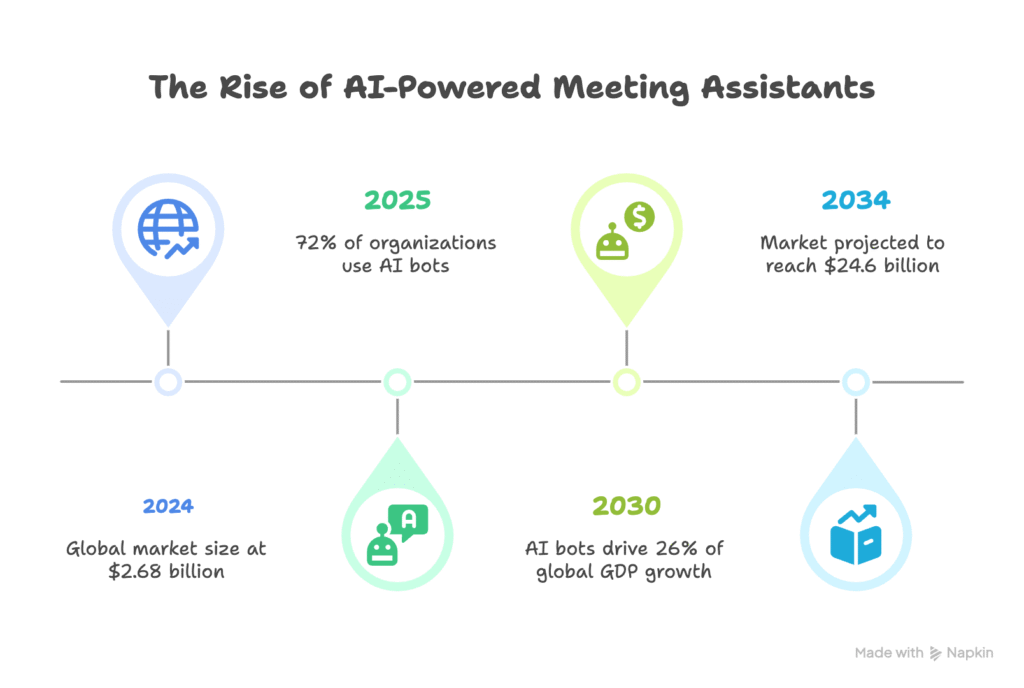
Common Names and Market Positioning
AI meeting bots are often marketed under various product terms, including:
- AI Meeting Assistants
- Automated Note-Takers
- Voice Intelligence Tools
- Virtual Collaboration Bots
Despite the names, they serve a singular purpose: enabling frictionless, intelligent meetings at scale.
Key Capabilities of AI Meeting Bots
1. Real-Time Transcription With Speaker Differentiation
AI bots transcribe every word of your meeting using high-accuracy speech recognition. Transcripts include:
- Speaker labels (identifying who said what)
- Timestamps for easy navigation
- Accent and dialect recognition for global teams
This feature is especially useful for distributed teams, legal documentation, compliance records, and multilingual workforces.
2. Actionable Meeting Summaries
Instead of going through pages of transcripts, AI bots generate concise summaries with:
- Bullet-point decisions
- Task assignments
- Agenda categorization
- Highlights of next steps
This feature ensures faster meeting recaps and better post-meeting alignment—ideal for product managers, team leads, and customer-facing roles.
3. Seamless Tool Integrations
AI meeting bots offer plug-and-play connectivity with leading productivity ecosystems:
- Task Managers: Asana, ClickUp, Trello, Notion
- Communication Tools: Slack, Microsoft Teams, Discord
- CRMs: HubSpot, Salesforce, Zoho
- Calendars: Google Calendar, Outlook
Automated syncing reduces manual updates, making it easier to follow through after meetings.
4. Voice-Activated Functionality
Some AI meeting tools feature built-in voice command recognition. You can trigger actions like:
- “Send me the recap”
- “Schedule follow-up for Friday”
- “Tag this for the marketing team”
These capabilities mirror the convenience of Siri or Alexa but with productivity-focused intent.
5. Multi-Language Support and Localization
Many bots support transcription and summarization in multiple languages, ideal for global teams. Features often include:
- Accent adaptation
- Language Translation
- Real-time cross-language collaboration
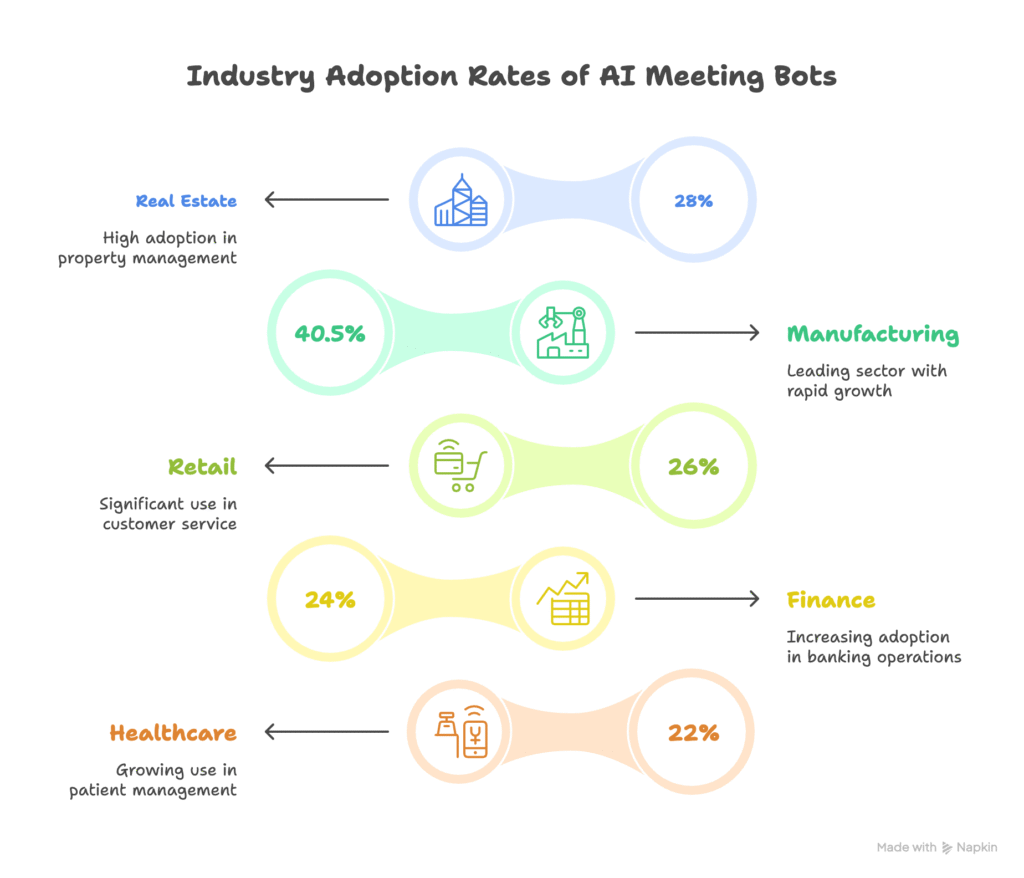
Strategic Use Cases Across Business Functions
AI meeting bots are not just tools for transcription—they are cross-functional productivity accelerators.
By automating documentation, summarization, and workflow integration, they address critical challenges in project management, sales enablement, talent acquisition, and customer operations.
Here’s how these intelligent assistants create measurable impact across departments.
1. Project Collaboration & Agile Team Stand-Ups
For product managers, developers, and operations teams using platforms like Jira, ClickUp, Trello, or Notion, AI meeting bots act as a real-time bridge between meetings and actionable outcomes. They eliminate the gap between conversation and execution by:
- Auto-logging tasks and user stories based on verbal discussion
- Assigning responsibility to team members automatically, reducing ambiguity
- Time-stamping decisions for accountability and sprint velocity reviews
- Syncing updates into agile boards to keep backlogs current without manual entry
This is especially critical in agile and DevOps environments where daily scrums, sprint planning, and retrospectives require quick turnaround on follow-ups and accurate traceability.
2. Sales Calls & Revenue Pipeline Management
In sales-driven organizations, AI meeting bots are redefining how reps manage their calls.
Whether it’s a discovery call, negotiation, or follow-up, the bot ensures that every touchpoint is documented, structured, and translate d into actionable sales intelligence. Core benefits include:
- Recording client objections and sales signals to refine messaging
- Creating structured call summaries segmented by objection, need, budget, or timeline
- Auto-syncing notes and action items into CRM systems like Salesforce, HubSpot, Zoho, or Pipedrive
- Generating follow-up reminders and next-step tasks to prevent drop-offs in the sales cycle
Sales leaders gain more accurate forecasting, better coaching data, and improved rep productivity—without relying on manual note uploads.
3. HR Interviews, Onboarding & Talent Evaluations
For HR departments and hiring managers, AI meeting bots provide a structured layer of documentation and evaluation during candidate interviews and employee reviews. Their key contributions include:
- Transcribing interviews with timestamped clarity—reducing reliance on memory or shorthand
- Standardizing evaluation criteria with consistent documentation across interviewers and locations
- Highlighting key candidate insights (e.g., experience relevance, behavioral signals, skills match)
- Supporting unbiased decision-making with neutral, data-driven transcripts
Whether you’re scaling hiring across regions or running performance reviews, bots ensure fair assessments, internal alignment, and audit-ready HR records.
4. Customer Support, Training & Internal QA
AI bots extend significant value to customer service operations by recording support calls, analyzing interactions, and transforming recurring queries into documentation assets.
This enables support managers and success teams to:
- Identify high-frequency issues and product pain points through conversation analysis
- Tag and categorize support interactions by topic, urgency, or product module
- Generate training materials, FAQs, and troubleshooting guides from real customer calls
- Track support agent performance with call summaries and sentiment analysis
This not only accelerates internal training and onboarding, but also improves first-call resolution, customer satisfaction, and product team feedback loops.
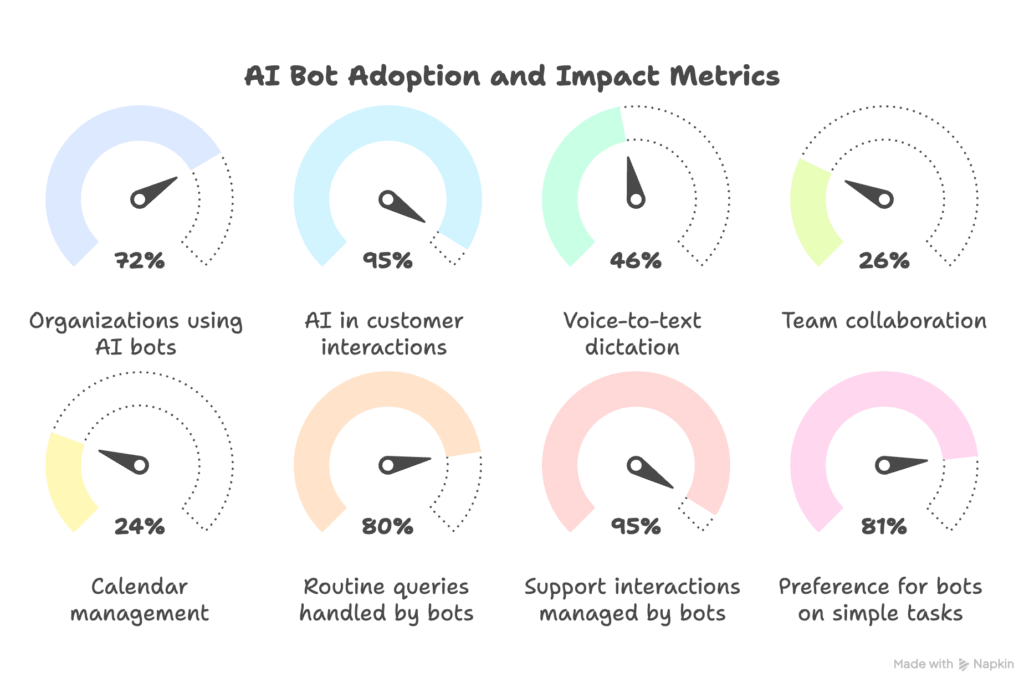
The Future of AI-Powered Meetings
AI meeting bots are rapidly evolving from passive notetakers into proactive, intelligent meeting facilitators.
Their capabilities are expanding into predictive analytics, voice-first interaction, and hyper-personalized collaboration experiences—positioning them as foundational tools for the AI-enabled workplace.
1. AI-Driven Analytics and Real-Time Meeting Intelligence
Next-gen AI bots will go beyond transcription and summarization by incorporating conversational analytics that measure meeting quality, team dynamics, and communication efficiency. This innovation will empower managers, project owners, and HR teams with actionable insights through:
- Talk-time heatmaps that visualize speaking time per participant, highlighting dominance or imbalance
- Engagement scoring models that assess interaction levels and detect silence, interruptions, or distractions
- Cross-meeting trend recognition to surface recurring bottlenecks, repeated concerns, or frequently raised objections
These data-rich features provide visibility into team behavior, improve meeting equity, and allow continuous improvement of internal processes.
2. Voice-First Meeting Management
Voice-enabled AI bots are set to revolutionize the meeting experience by eliminating the need for manual navigation or typed input.
As part of a growing shift toward hands-free productivity, users will be able to:
- Initiate recordings or summaries with simple voice commands
- Assign follow-up tasks or set reminders verbally
- Control meeting actions without switching windows or devices
This approach mirrors digital assistants like Siri, Alexa, and Google Assistant, but applied to enterprise collaboration environments.
The result: faster interaction, less friction, and improved accessibility—especially beneficial during remote work, mobile calls, or hands-busy workflows.
3. Personalized AI Collaboration Agents
In the next evolution of AI meeting bots, personalization will move beyond default settings. These tools will adapt to individual users by learning their work style, departmental goals, and preferred toolsets. Expect bots to offer:
- Tailored summaries based on user function (e.g., legal compliance details for legal teams, technical actions for engineers)
- Context-aware suggestions, such as auto-generating a client follow-up template post-call
- Adaptive integrations that sync with each user’s most-used platforms and optimize for personal productivity patterns
This role-aware design will eliminate irrelevant noise, deliver higher signal value, and boost performance across functions from sales and marketing to engineering and support.
How to Choose the Right AI Meeting Bot
Not all AI meeting bots are built the same. To select the right fit for your business, evaluate both technical specifications and practical utility across your organization’s workflow.
Focus on:
1. Core Functional Features
Look for solutions that offer:
- Real-time transcription with speaker recognition
- Meeting summaries with task tagging
- Voice-command functionality
- AI-driven analytics and engagement scoring
These ensure operational efficiency across departments and meeting types.
2. Tool Compatibility and Workflow Integration
Your AI meeting assistant should offer plug-and-play compatibility with:
- Video conferencing platforms: Zoom, Google Meet, Microsoft Teams
- Team collaboration suites: Slack, Trello, ClickUp, Notion
- CRM systems: Salesforce, HubSpot, Zoho
- Calendars: Google Calendar, Outlook, iCal
Integration depth matters—especially for syncing tasks, automating notes, and eliminating duplicate workflows.
3. Language, Accessibility, and Localization
For global or multilingual teams, choose bots with:
- Multi-language transcription
- Accent adaptability and regional language support
- Real-time translation capabilities if needed
This is vital for international meetings, BPO operations, and distributed teams.
4. Data Security and Compliance Readiness
Ensure the tool meets enterprise-grade compliance standards such as:
- End-to-end encryption
- GDPR, SOC 2, and HIPAA compliance (as applicable)
- Role-based access controls
- Private deployment options (cloud or on-premise)
Especially crucial for industries like healthcare, legal, finance, and government where data privacy is non-negotiable.
5. Scalability and Pricing Flexibility
Choose platforms that scale with your business by offering:
- Flexible pricing tiers (by user, by usage, or per transcription hour)
- Team-based admin controls
- Enterprise-level onboarding and support
This ensures cost efficiency whether you’re a startup, SMB, or enterprise.
Try MeetStream API to Build Your AI Meeting Bot!
If you’re building a product that needs intelligent meeting capabilities, MeetStream.ai gives you the raw API access to do it your way. Unlike cookie-cutter platforms with rigid interfaces, MeetStream.ai is designed for developers who want full control. With our clean, developer-first API, you can embed powerful meeting bot functionality directly into your platform — from virtual collaboration tools to CRMs, LMSs, or internal dashboards.
MeetStream.ai’s raw API lets you automate the entire meeting experience. Capture live conversations, extract action items and decisions, summarize discussions in real time, and sync everything with your existing workflows — all without building your own AI infrastructure from scratch. Whether you’re handling internal team calls or client-facing discussions, our API transforms voice and video content into structured, actionable data instantly.
The best part? You’re not locked into someone else’s UI. You get complete freedom to create a branded experience on top of our engine. Customize the prompts, control the output, and deliver insights that fit your product — not the other way around. MeetStream.ai is the invisible powerhouse behind intelligent meeting automation, giving you the tools to innovate faster.
Final Thoughts: The Future of Meetings Is AI-Driven
AI meeting bots are no longer a novelty—they are fast becoming a standard productivity layer in the modern workplace.
From streamlining meeting documentation to syncing tasks across tools, these assistants are designed to optimize how businesses collaborate.
Invest in a solution that suits your team’s workflow, enhances productivity, and ensures you never miss a critical insight again.

